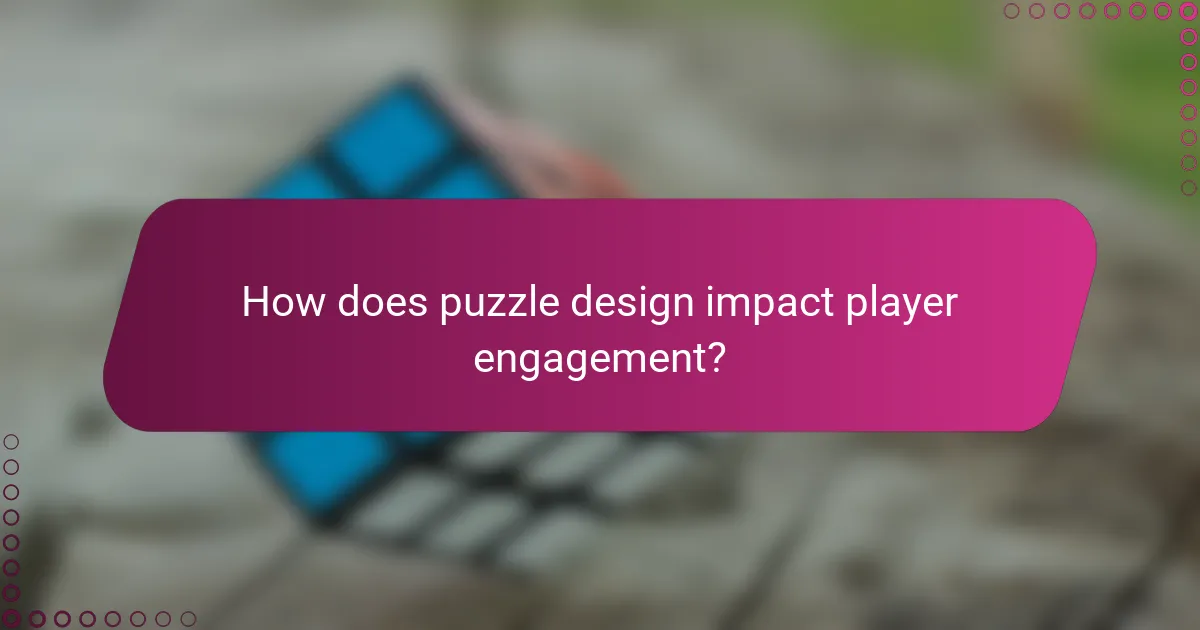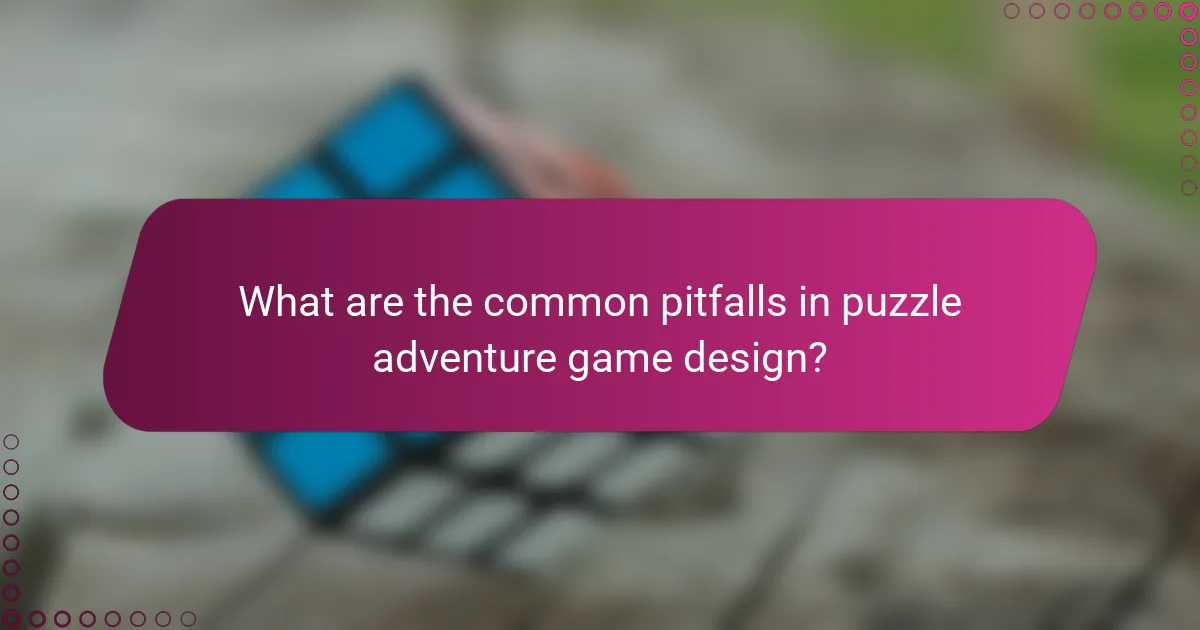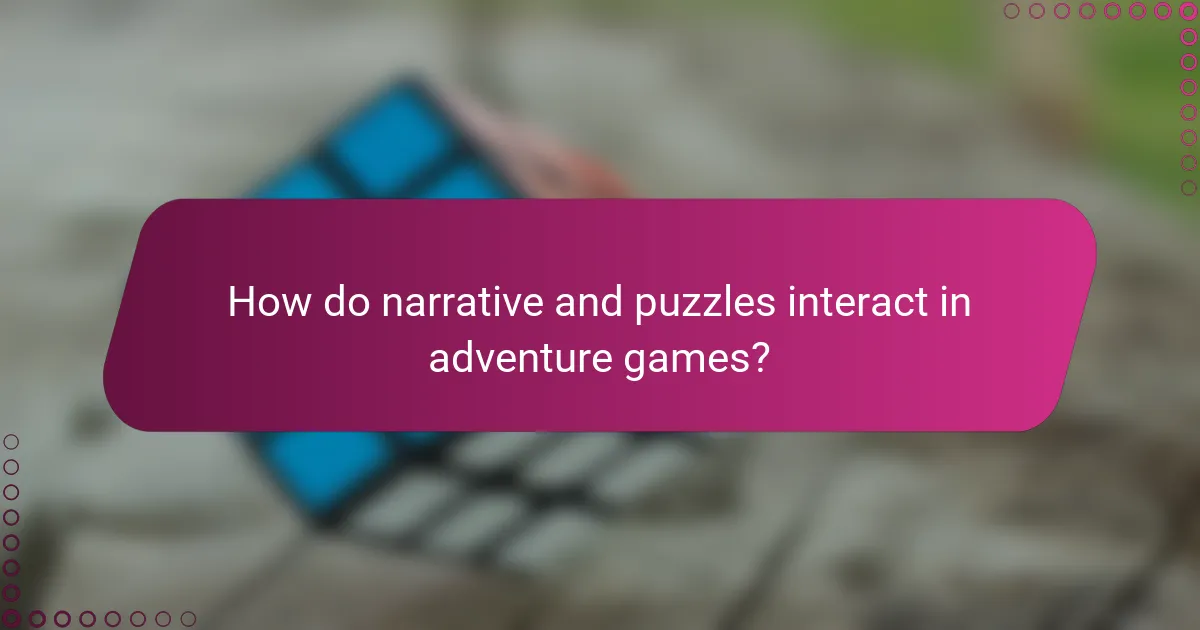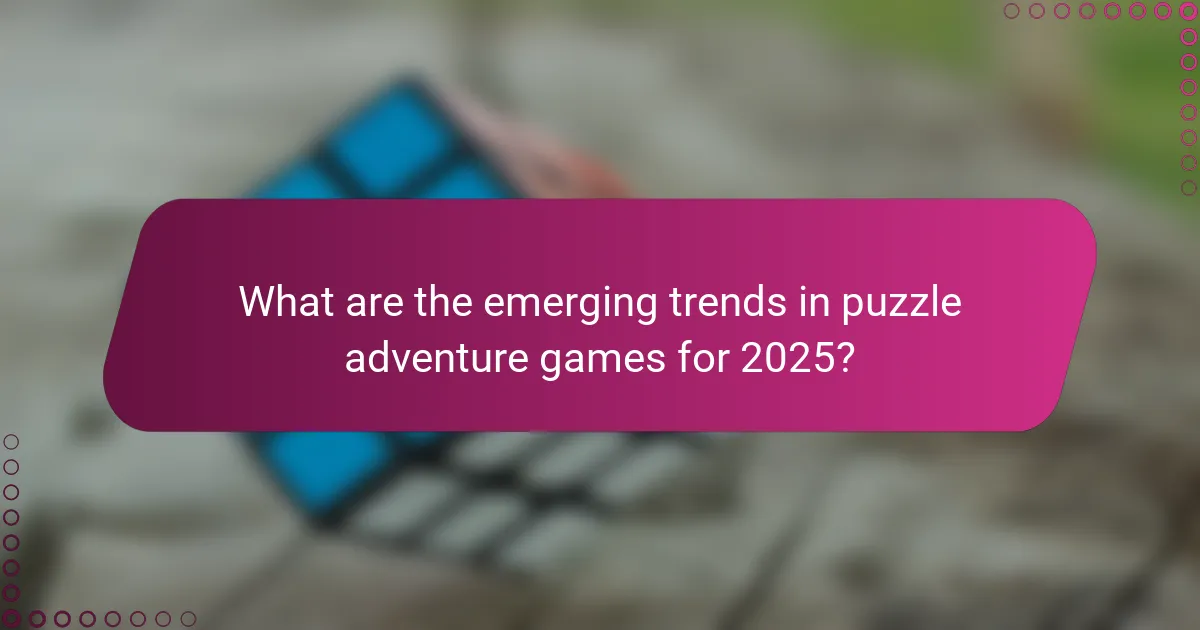Puzzle adventure games captivate players by combining engaging challenges with immersive storytelling. This article analyses effective puzzle design, highlighting the importance of balance, clarity, and player feedback. It also discusses common pitfalls that can detract from gameplay and explores emerging trends like AI integration and sustainability themes that are shaping the future of the genre. Understanding these elements can enhance player experience and satisfaction.

How does puzzle design impact player engagement?
Puzzle design significantly enhances player engagement by creating challenges that stimulate problem-solving and exploration. Effective puzzles integrate seamlessly into the narrative and mechanics of the game, encouraging players to think critically and feel accomplished upon solving them.
A well-designed puzzle maintains a balance between difficulty and accessibility, ensuring players remain motivated without feeling frustrated. Unique attributes, such as innovative mechanics or thematic relevance, can further captivate players, making the gameplay experience memorable.
Moreover, puzzles that evolve in complexity throughout the game keep players invested, as they anticipate new challenges and solutions. Engaging puzzle design not only enriches gameplay but also fosters emotional connections to the game world.
What are the key elements of effective puzzle mechanics?
Effective puzzle mechanics in adventure games include clarity, challenge, and integration with the narrative. Clear objectives guide players, while appropriate difficulty maintains engagement. Puzzles should seamlessly connect to the storyline, enhancing immersion. Unique attributes like innovative mechanics can differentiate a game, while rare attributes such as environmental puzzles provide variety. Balancing these elements ensures a rewarding gameplay experience.
Why is player feedback essential in puzzle design?
Player feedback is essential in puzzle design because it directly influences gameplay quality and player satisfaction. Understanding player experiences helps designers refine challenges, ensuring they are engaging and appropriately difficult. Feedback reveals which puzzles resonate, allowing for adjustments that enhance flow and immersion. Additionally, player insights can uncover unique attributes of puzzles that may not align with initial design intentions, leading to innovative solutions and improved overall game dynamics. Incorporating this feedback fosters a more enjoyable and rewarding experience for players, ultimately contributing to a game’s success.

Which psychological principles enhance puzzle-solving experiences?
Psychological principles that enhance puzzle-solving experiences include challenge, reward, and flow. These principles create engagement and satisfaction in puzzle adventure games.
Challenge keeps players motivated by presenting tasks that require skill and strategy. Reward systems provide positive reinforcement, encouraging continued play. Flow occurs when players experience a balance between skill and challenge, leading to immersive gameplay.
Incorporating these principles can significantly improve player experiences by fostering a sense of achievement and enjoyment.
How do challenge levels affect player satisfaction?
Challenge levels significantly impact player satisfaction by influencing engagement and motivation. Balancing difficulty ensures players feel challenged yet capable, enhancing their overall experience. Too easy puzzles may lead to boredom, while overly difficult ones can cause frustration. A well-designed challenge level fosters a sense of achievement, encouraging players to continue progressing. This balance is crucial in puzzle adventure games, where player satisfaction hinges on the interplay between challenge and skill.
What role does cognitive load play in puzzle design?
Cognitive load significantly impacts puzzle design by influencing player engagement and problem-solving efficiency. High cognitive load can overwhelm players, while optimal load enhances critical thinking and enjoyment. Balancing complexity with clarity is essential for effective puzzle experiences. Designers must consider the type of puzzles, player skill levels, and feedback mechanisms to maintain an engaging challenge without causing frustration.

What are the common pitfalls in puzzle adventure game design?
Common pitfalls in puzzle adventure game design include overcomplicated puzzles, lack of clarity, poor pacing, and insufficient player feedback. These issues can frustrate players and detract from the overall experience.
Overcomplicated puzzles can lead to player confusion, making it difficult to progress. Lack of clarity in puzzle instructions or objectives can result in players feeling lost. Poor pacing disrupts the flow of gameplay, causing players to lose interest. Insufficient feedback can leave players unsure if they are on the right track, leading to disengagement.
Addressing these pitfalls enhances player enjoyment and encourages continued engagement with the game.
How can designers avoid frustrating players?
Designers can avoid frustrating players by ensuring puzzles are intuitive and rewarding. Clear instructions and logical progression enhance player engagement. Incorporating feedback mechanisms allows players to learn from mistakes without feeling penalised. Balancing challenge with accessibility keeps the gameplay enjoyable. Engaging narrative elements can also provide context, making puzzles feel meaningful.
What are the consequences of poorly designed puzzles?
Poorly designed puzzles can lead to frustration, disengagement, and a negative gaming experience. Players may struggle to understand objectives, resulting in confusion and abandonment of the game. Additionally, inconsistent difficulty levels can alienate both novice and experienced players, diminishing overall enjoyment. Effective puzzle design should balance challenge and clarity to enhance gameplay.

How do narrative and puzzles interact in adventure games?
Narrative and puzzles in adventure games enhance gameplay by creating immersive experiences. Puzzles drive the story forward, engaging players through challenges that reveal plot elements. Narrative context enriches puzzle design, providing motivation and emotional stakes. Effective integration ensures puzzles feel organic and relevant, maintaining player interest while promoting exploration. This synergy fosters a deeper connection to the game world, enhancing overall enjoyment and satisfaction.
Why is storytelling important in puzzle integration?
Storytelling is crucial in puzzle integration because it enhances player engagement and immersion. A compelling narrative provides context for puzzles, making them more meaningful and memorable. This connection motivates players to solve challenges, as they feel invested in the story’s outcome. Additionally, storytelling can guide puzzle design, ensuring that each challenge aligns with the overall narrative arc. By weaving puzzles into the storyline, developers create a cohesive experience that deepens player satisfaction and encourages exploration.
Which techniques enhance narrative-driven puzzles?
Engaging narrative-driven puzzles utilize techniques like character-driven storytelling, environmental clues, and thematic integration. These elements enhance immersion and challenge players to think critically about the narrative context. Incorporating branching storylines can also deepen player engagement, offering unique attributes that differentiate gameplay experiences. Additionally, puzzles that evolve based on player choices create a dynamic interaction, making each playthrough distinct.

What unique attributes set apart successful puzzle adventure games?
Successful puzzle adventure games often feature immersive storytelling, innovative mechanics, and engaging puzzles. Unique attributes include a seamless integration of narrative and gameplay, which enhances player investment. Additionally, adaptive difficulty levels cater to diverse skill sets, ensuring accessibility. A distinctive art style can also set a game apart, creating a memorable visual experience. Lastly, strong character development adds depth, making players more emotionally connected to the journey.
How do innovative mechanics create memorable experiences?
Innovative mechanics enhance puzzle adventure games by creating engaging and memorable experiences through unique challenges. These mechanics encourage critical thinking and exploration, fostering a sense of achievement. For example, integrating narrative elements with puzzles deepens player immersion, making each solution feel significant. Additionally, adaptive difficulty adjusts challenges based on player performance, ensuring a tailored experience that maintains interest. Ultimately, innovative mechanics elevate gameplay by balancing complexity with accessibility, leading to lasting impressions.
Which games exemplify groundbreaking puzzle design?
Games that exemplify groundbreaking puzzle design include “The Witness,” “Portal,” and “Baba Is You.” Each game showcases unique mechanics and innovative problem-solving approaches that enhance player engagement.
“The Witness” features a vast open world filled with intricate line puzzles that require observation and pattern recognition. “Portal” introduces spatial reasoning through its iconic portal gun, allowing players to manipulate environments creatively. “Baba Is You” employs a unique rule-altering mechanic, where players change the game’s logic to solve puzzles.
These games demonstrate how innovative puzzle design can transform gameplay, encouraging critical thinking and exploration.

What are the emerging trends in puzzle adventure games for 2025?
Emerging trends in puzzle adventure games for 2025 focus on immersive storytelling, AI-driven puzzles, and enhanced multiplayer experiences. These elements aim to deepen player engagement and interaction.
AI integration will personalise challenges, adapting to player skill levels. Enhanced graphics and virtual reality will create more immersive environments, allowing players to explore intricate worlds. Additionally, cross-platform compatibility will enable wider accessibility, fostering community engagement.
Sustainability themes are gaining prominence, with developers incorporating eco-friendly narratives. Gamification of learning elements will also emerge, blending education with entertainment.
Overall, these trends are set to redefine puzzle adventure gaming, prioritising player experience and innovative gameplay mechanics.
How is technology shaping the future of puzzle design?
Technology is revolutionising puzzle design by enhancing interactivity and player engagement. Advanced algorithms analyse player behaviour, tailoring challenges to individual skill levels. Virtual reality creates immersive environments, allowing players to solve puzzles in 3D spaces. Additionally, AI-generated puzzles offer endless variations, increasing replayability. Mobile platforms enable accessibility, reaching a broader audience. Finally, community-driven content fosters collaboration, enriching the gaming experience.
What role do multiplayer elements play in puzzle adventures?
Multiplayer elements enhance puzzle adventure games by fostering collaboration and competition among players. They encourage social interaction, which can lead to innovative problem-solving strategies. Cooperative gameplay allows players to share ideas and work together on complex puzzles, creating a more engaging experience. Additionally, competitive aspects can motivate players to improve their skills and achieve higher scores. Overall, multiplayer features enrich gameplay by combining individual puzzle-solving with social dynamics.
What best practices should designers follow for optimal gameplay?
Designers should focus on creating engaging and balanced puzzles for optimal gameplay. Effective puzzle design enhances player experience and promotes problem-solving skills.
First, ensure puzzles are intuitive yet challenging. Players should feel a sense of accomplishment upon solving them. Incorporate a variety of puzzle types to cater to different player preferences.
Second, provide clear feedback. Visual and auditory cues can reinforce player actions and guide them toward solutions. This enhances immersion and satisfaction.
Third, maintain a logical flow. Puzzles should be interconnected, allowing players to build on their knowledge and skills as they progress. This encourages exploration and discovery.
Finally, playtest extensively. Gather player feedback to identify any frustrations and refine puzzle mechanics. Iterative testing leads to a more polished and enjoyable gameplay experience.




